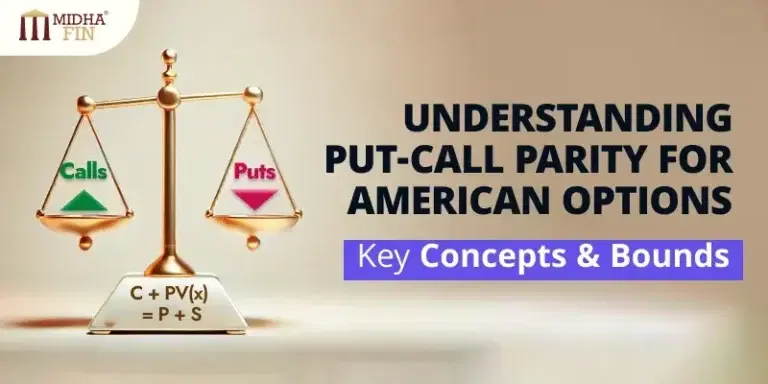Risk Management |
Trading
Understanding Put-Call Parity for American Options : Key Concepts and Bounds

Put-call parity is a foundational principle in options pricing, establishing a relationship between the prices of call and put options with the same strike price and expiration date. While this concept is straightforward for European options, it becomes more nuanced when applied to American options. American options allow early exercise, which introduces complexities that affect the parity relationship, resulting in inequalities rather than exact equations.
In this article, we’ll explore the concept of put-call parity for American options, understand why it differs from European options, and explain how to calculate the upper and lower bounds for the difference between the prices of American call and put options on non-dividend-paying stocks. For dividend-paying stocks, an additional factor is introduced to account for the expected dividend payments.
The Basics of Put-Call Parity
Put-call parity provides a relationship between the prices of call and put options on the same underlying asset, with the same strike price and expiration date. This relationship is based on the fact that the payoff from holding a call and a put option can be replicated through other positions in the underlying asset and a risk-free bond.
For European options (which can only be exercised at expiration), the put-call parity is expressed as a strict equation. The difference between the call and put prices is exactly equal to the difference between the current stock price and the present value of the strike price, which is the strike price discounted at the risk-free rate over the option’s life:
C – P = S₀ – PV(X)
where:
- C = Price of the European call option
- P = Price of the European put option
- S₀ = Current price of the underlying asset
- PV(X) = Present value of the strike price, calculated as X * e^(-rT), where:
- X is the strike price
- r is the continuously compounded risk-free interest rate
- T is the time to maturity
This equation holds because both sides represent equivalent positions, eliminating arbitrage opportunities in an efficient market. However, things change when it comes to American options, which allow early exercise.
Put-Call Parity for American Options: Why It’s Different
Unlike European options, American options can be exercised at any time before or at expiration. This flexibility introduces an additional factor in their valuation. The potential for early exercise means that the relationship between call and put prices is less rigid, leading to an inequality instead of an exact equality.
For American options on non-dividend-paying stocks, the put-call parity relationship is represented as a range, or bounds, for the difference between the call and put prices:
S₀ – X ≤ C – P ≤ S₀ – PV(X)
This provides an upper and lower limit for the difference between the call and put prices, where:
- Lower Bound (S₀ – X): The lower bound represents the minimum difference between the call and put prices for American options. It accounts for the immediate exercise value of the call option (the in-the-money amount) if exercised immediately, reflecting the flexibility of American options.
- Upper Bound (S₀ – PV(X)): The upper bound represents the maximum difference between the call and put prices, assuming no early exercise. It is equivalent to the put-call parity formula for European options, assuming the options are held until expiration.
These bounds mean that the difference between the call and put prices of American options lies somewhere between the lower and upper bounds but does not necessarily settle at a specific value, as it would for European options.It’s essential to note that the actual difference can vary anywhere within this range depending on market factors and the possibility of early exercise.
Extending Put-Call Parity to Dividend-Paying Stocks
For dividend-paying stocks, put-call parity for American options introduces an additional factor to account for expected dividends. When a stock pays dividends, the call option may become less valuable (since the stock price tends to drop by the dividend amount on the ex-dividend date), while the put option may become more valuable.
In this case, the put-call parity inequality for American options adjusts to include the present value of expected dividends (PV(D)):
S₀ – X + PV(D) ≤ C – P ≤ S₀ – PV(X) + PV(D)
where PV(D) represents the present value of expected dividends to be paid during the option’s life. This adjustment ensures that the put-call parity reflects the effect of dividend payments on the underlying asset’s price and, consequently, on the options’ prices.
Why These Bounds Matter
Understanding the bounds for the difference between American call and put options is crucial for several reasons:
- Arbitrage Opportunities:
- Knowing the bounds helps traders identify potential arbitrage opportunities. If the difference between the call and put prices falls outside these bounds, it could indicate a mispricing, allowing for arbitrage.
- Pricing Insights:
- The bounds provide a benchmark for evaluating American option prices. By comparing actual market prices with the calculated bounds, traders can gain insights into whether an option is fairly priced relative to its counterpart.
- Risk Management:
- The upper and lower bounds also help in managing risk by setting realistic expectations for option price differences. This can be especially useful for portfolio hedging strategies that involve American options.
Conclusion
Put-call parity is a foundational concept in options pricing, but it’s crucial to understand how it differs between American and European options. For American options, early exercise rights mean that the difference between call and put prices is bounded rather than fixed. By calculating these bounds, traders and investors can better assess the pricing of American options, spot potential arbitrage opportunities, and manage risk.
For American options on dividend-paying stocks, an additional adjustment is made to include the present value of expected dividends, further refining the bounds. Understanding these nuances can enhance your options trading strategies, particularly when dealing with American-style options, where the possibility of early exercise and dividends add layers of complexity to pricing and parity relationships.


